Understanding Vodka: The Clear Spirit Explained
Ever wondered what is vodka? This clear, versatile spirit is a global favorite, prized for its mixability and smooth character. It's more than a drink; it's a testament to centuries of distillation artistry.
Here's a quick look at what defines vodka:
- Clear, Distilled Spirit: Vodka is a colorless, unaged liquor.
- Primary Ingredients: It's mainly composed of water and ethanol.
- Made from Fermentable Bases: It can be crafted from almost any plant material rich in sugar or starch. Common bases include grains (wheat, rye, corn) and potatoes.
- Alcohol Content: Typically ranges from 37.5% to 55% alcohol by volume (ABV).
- Neutral Character: Traditionally, vodka is known for its neutral aroma and taste, making it highly adaptable.
Its journey from "little water"—the diminutive of the Slavic word 'voda'—to a global icon is fascinating, embracing both tradition and innovation.
Sylwester Skóra, co-founder of Two Flags™ Vodka, brings a deep understanding of what is vodka from its rich Polish traditions to American innovation. Inspired by General Casimir Pulaski, our brand embodies craftsmanship and authenticity, committed to delivering an unparalleled vodka experience.
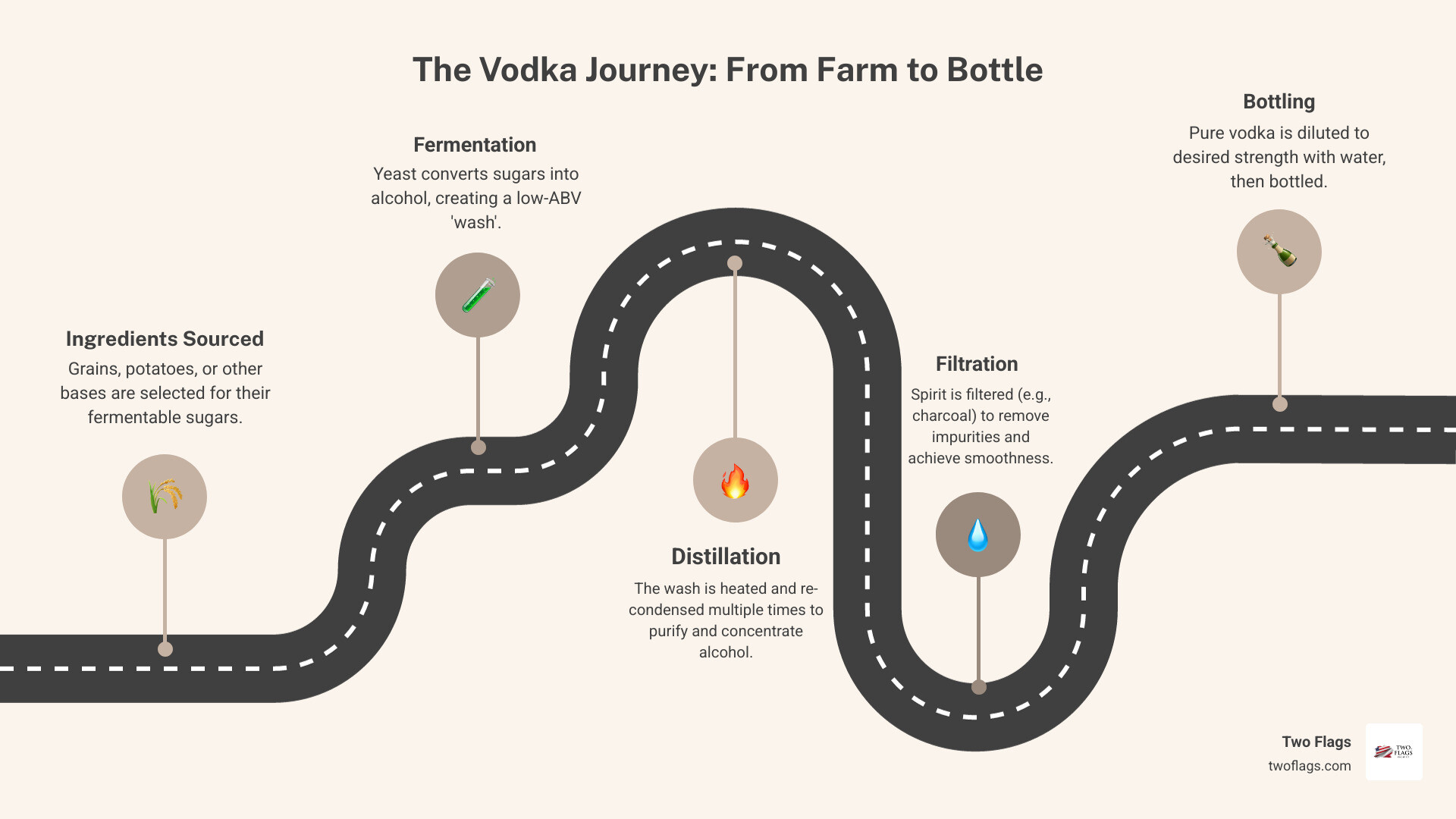
Quick look at what is vodka:
The Heart of the Spirit: Ingredients and Origins
At its core, what is vodka is a blend of nature's bounty and human ingenuity. The magic begins with its fundamental ingredients—fermentable starches or sugars and pure, clean water. This foundation, coupled with a rich and debated history, shapes the soul of vodka.
What is vodka made from?
One of vodka's most exciting traits is its flexibility. Unlike spirits tied to a single ingredient, vodka can be crafted from almost any plant material rich in fermentable sugars. This adaptability is a defining characteristic of what is vodka.
Historically, some of the most classic bases include:
- Potatoes: These earthy tubers are a time-honored choice, especially cherished in Poland. Vodkas made from potatoes often offer a wonderfully full-bodied and creamy experience, sometimes with subtle savory or even nutty hints. At Two Flags™, we're proud to use premium Polish potatoes, which contribute to our vodka's exceptionally smooth character.
-
Cereal Grains: Grains like rye and wheat are staples in many traditional "vodka belt" countries.
- Rye often delivers a bolder, spicier flavor profile, making for a truly robust vodka.
- Wheat tends to produce a lighter, crisper, and often subtly sweet spirit, known for its clean and approachable taste.
Innovation doesn't stop there. Today's distillers explore a fascinating array of other ingredients. You might find vodkas made from corn (which often yields a lighter, sweeter, sometimes buttery spirit), grapes, sugar cane, quinoa, olives, rice, whey (a dairy by-product), maple sap, or even honey. Each choice imparts its own unique, subtle characteristics, proving that not all vodkas are perfectly "flavorless."
And here's a common question: what about gluten? It's interesting to note that despite being made from ingredients like wheat or barley, vodka is widely considered gluten-free thanks to the distillation process. This clever method effectively separates the alcohol from any larger gluten proteins. For a deeper dive into this, you can read The Truth About Gluten in Vodka: A Clear Explanation.
A Spirited Debate: The History of Vodka
The tale of vodka is as deep as its production methods. The name "vodka" is a diminutive of the Slavic word "voda," meaning "water"—literally "little water." This etymology hints at its fundamental role in the cultures where it originated.
Pinpointing vodka's exact birthplace is a lively, centuries-old debate among historians and enthusiasts. Both Poland and Russia lay strong claims to its origin, with historical records suggesting its presence as early as the 8th or 9th century in either region. Poland boasts an early mention of the word "vodka" dating back to 1405, while the first Russian reference appears in 1751.
Early vodka was quite different from the polished spirit we enjoy today. It was initially valued for its medicinal purposes, believed to cure ailments and even treat conditions like poison ivy. Before becoming a social beverage, it was also used in cosmetics and as a powerful cleaner.
This rich early history cemented vodka's importance in what is now known as the "vodka belt"—a region stretching across Eastern and Northern Europe. Countries like Poland, Russia, Ukraine, Belarus, and Sweden share deep cultural ties with vodka production and consumption. In these regions, it's a long-standing tradition to savor vodka unmixed and chilled, often alongside a spread of delicious appetizers. For more on vodka's fascinating journey through time, you can explore More on vodka's history from Britannica.
The Art of Purity: How Vodka is Crafted
The change of raw ingredients into the crystal-clear spirit we know as vodka is an art form. Understanding what is vodka means appreciating the careful process of fermentation, distillation, and filtration. Each step aims for the perfect balance of purity and character.
Fermentation: Creating the Alcohol Base
The magic begins with a "mash." Starches from potatoes, wheat, rye, or corn must be converted into fermentable sugars. This is done through malting or by adding enzymes.
Once we have those sugars, water is added to create a "wash" or "wort."
Yeast is then introduced to the sugary wash. These microorganisms consume the sugar, converting it into ethanol and carbon dioxide. This process takes several days, resulting in a low-alcohol liquid similar to a strong beer.
Distillation: The Pursuit of a Pure Spirit
The heart of crafting vodka is distillation. Here, the alcoholic wash is transformed, separating the alcohol from water and other compounds called congeners.
The concept is simple: the wash is heated in a still. Since alcohol has a lower boiling point than water, it vaporizes first. These alcohol vapors are collected and cooled back into a liquid with a much higher alcohol content.
Column stills are the workhorses of modern vodka production, allowing for continuous distillation to produce a very high-proof, neutral spirit. Pot stills, the traditional copper stills, require multiple runs but are often chosen when distillers want to retain some character from the base ingredients.
Surprisingly, the idea that "more distillation is always better" is a myth. While multiple distillations can increase purity, a single, controlled distillation can be ideal for high-quality ingredients, allowing subtle flavors from premium grains or potatoes to shine through.
To earn the title of vodka in the United States, the spirit must be distilled to at least 190 proof—that's 95% alcohol by volume. This high proof ensures the pure, neutral character that defines the spirit. You can dive deeper into this fascinating process in Vodka's Journey: A Step-by-Step Guide to How It's Crafted.
Filtration and Bottling: The Finishing Touches

After distillation, filtration refines the spirit, creating the signature smoothness of quality vodka.
Filtration removes lingering impurities and unwanted congeners that cause harsh flavors or aromas. Charcoal filtration is the gold standard. Invented by Russians in the 18th century, it remains the most effective method.
Activated charcoal, often from birchwood or coconut shells, is incredibly porous. It acts like a microscopic sponge, adsorbing impurities while leaving a cleaner, smoother spirit. Some distillers use other materials like quartz, paper, or metallic filters to achieve specific textures.
Once filtered, the high-proof spirit is diluted with water to its final bottling strength. This step is crucial, as water makes up roughly 60% of the final product. The quality of this water matters enormously—many distilleries use pristine artesian wells, natural springs, or purified water.
The final step is bottling. Unlike whiskey or brandy, vodka requires no aging. It's bottled immediately after production, ready to be enjoyed. This immediate availability is a key characteristic of what is vodka. The entire process requires precision and care. Learn more about why this filtration stage is so critical in Why Vodka Filtration Matters: A Deep Dive.
By the Numbers: What is Vodka's Profile?
When people ask what is vodka, they're often curious about the facts: its strength, varieties, and health implications. Let's explore the numbers that define this spirit.
Alcohol Content: ABV and Proof Explained
Vodka's strength is measured in two ways. Alcohol By Volume (ABV) is the percentage of pure alcohol in the bottle. A 40% ABV label means 40% of the liquid is pure ethanol.
In the United States, proof is simply double the ABV. A 40% ABV vodka is 80 proof. This system dates back to old tax laws.
In the United States, vodka must be at least 40% ABV (80 proof). In the European Union, the minimum is 37.5% ABV (75 proof).
Most vodkas are 40% ABV, but some reach 46% or higher. Higher proof vodkas have more punch for cocktails, while lower proof options are smoother neat.
At Two Flags™, we've found that sweet spot that honors our Polish heritage while delivering the clean, smooth character our customers love. For a deeper look at vodka's potency, check out Is Vodka Alcoholic and How Potent Is It?.
Styles, Characteristics, and Nutrition
Traditionally, what is vodka is defined as clear, colorless, and neutral. However, the "neutral" aspect is evolving as craft distillers accept the subtle flavors from their base ingredients.
Vodka styles fall into two broad camps. Eastern Style vodkas, from Poland and Russia, often have subtle earthy notes from potatoes or spicy warmth from rye. These are often sipped neat and chilled. Western Style vodkas lean into maximum neutrality, creating the perfect clean canvas for cocktails.
Flavored vodkas offer endless creativity, from classic citrus and vanilla to bold pepper and botanical infusions.
Different base ingredients create distinct personalities. Potato vodkas like our Two Flags™ offer a fuller body with a creamy, almost luxurious mouthfeel. Wheat-based vodkas are lighter and crisper, while rye vodkas bring spicy, robust character.
| Characteristic | Potato Vodka | Wheat Vodka | Rye Vodka |
|---|---|---|---|
| Body | Fuller, creamy | Lighter, crisp | Medium, robust |
| Mouthfeel | Fleshy, oily | Smooth, clean | Slightly peppery |
| Flavor Profile | Savory, earthy, nutty, subtle sweetness | Clean, mild, subtly sweet, sometimes citrus notes | Spicy, peppery, bold, some breadiness |
| Best For | Martinis, sipping neat | Versatile cocktails, light mixers | Heartier cocktails, neat with strong flavors |
What is vodka's nutritional impact?
For health-conscious drinkers, a standard 1.5-ounce shot of vodka contains approximately 97 calories, making it a lower-calorie alcoholic option.
Vodka has zero carbohydrates and zero sugar. The distillation process strips away everything but alcohol and water, making it suitable for low-carb and ketogenic lifestyles.
The gluten question is common. Even vodkas from wheat or barley are considered gluten-free because distillation removes the gluten proteins. The heat and separation process ensures the final product is free from the protein molecules that cause gluten sensitivity.
Of course, alcohol carries health risks when consumed excessively, including liver damage, addiction, and impaired judgment. The key is responsible enjoyment.
For detailed nutritional information, explore The Truth About Vodka Calories, Carbs, and Your Health. For comprehensive information about alcohol's health effects, WebMD's guide to drinking risks provides valuable insights.
Savoring the Spirit: How to Enjoy and Store Vodka
Now that we understand what is vodka, let's explore how to enjoy it. Whether sipped neat or in cocktails, its adaptability is key. Proper storage also ensures every drop tastes as the distiller intended.
Ways to Drink Vodka
Vodka's beauty is its flexibility. In Eastern Europe, it's often enjoyed neat—unmixed and chilled. This traditional approach lets you appreciate the spirit's character. Sipping a premium vodka like Two Flags™ neat reveals the subtle differences from quality ingredients and craftsmanship.
For a slightly mellowed experience, vodka on the rocks offers gentle dilution. Many enthusiasts keep their bottles chilled in the refrigerator or freezer for an incredibly smooth, silky drinking experience.
Vodka truly shines in classic cocktails. Its neutral profile is the perfect canvas for mixologists. The Vodka Martini is a sophisticated choice, while the Moscow Mule is refreshing with ginger beer and lime. The Cosmopolitan is fruity and vibrant, and the Bloody Mary is a savory brunch staple.
The mixability factor is what makes understanding what is vodka so exciting for cocktail lovers. It encourages creativity and lets personal taste shine. For more inspiration on serving and enjoying vodka, check out Vodka Unveiled: Your Guide to Serving and Sipping.

Beyond the Bar: Vodka in the Kitchen
Interestingly, what is vodka extends beyond drinking. Many chefs and home cooks use vodka in the kitchen. Its neutral flavor and unique properties are surprisingly useful for cooking and baking.
In dishes like Penne alla Vodka, the spirit helps emulsify the sauce, allowing tomatoes and cream to blend beautifully. The alcohol also acts as a flavor improver, carrying aromatic compounds more effectively than water before mostly evaporating during cooking.
Bakers have long known that vodka can create flakier pie crusts. When added to dough, the alcohol evaporates faster than water during baking, creating a tender texture without overdeveloping the gluten that makes crusts tough.
You'll also find vodka useful in marinades, for deglazing pans, and in some desserts where it adds a subtle kick.
Storage and Shelf Life: Does Vodka Go Bad?
A practical question about what is vodka is its longevity. The great news: pure distilled vodka has an incredibly long, essentially indefinite shelf life when unopened. Without sugars or other spoiling compounds, it's remarkably stable.
Once opened, slow oxidation begins. Over many years, this may cause slight changes in flavor, but it remains safe to drink. For peak quality, consume unopened bottles within 30-50 years and opened bottles within 10-20 years.
For the best experience, store your vodka in a cool, dark place away from direct sunlight and temperature swings.
Many people love storing vodka in the freezer. The alcohol content prevents it from freezing solid, creating a wonderfully viscous, chilled texture that's delightful for sipping neat. While some argue extreme cold can mute subtle flavors, most find the super-chilled experience worth it.
Don't worry about your bottle bursting in the freezer; it's designed to handle the cold. For more details on freezer storage, you can read The Cold Hard Facts: Will Your Vodka Bottle Burst in the Freezer?.
Frequently Asked Questions about Vodka
As we explore what is vodka, some questions frequently arise. Let's answer the most common ones to clear up any confusion.
How does vodka differ from gin?
This is a common question. While both vodka and gin are clear spirits, they are quite different.
The simple truth is that gin is essentially flavored vodka. Both begin as a neutral spirit, but gin is then infused with botanicals. The key botanical is juniper berries—without them, it isn't gin.
So when you're sipping vodka, you're experiencing the pure essence of its base ingredient, such as the premium potatoes used in our spirit. When enjoying gin, you're tasting that neutral spirit foundation transformed with aromatic herbs, spices, and juniper.
Think of vodka as a blank canvas, while gin is that same canvas with a beautiful botanical painting on top.
Is all vodka gluten-free?
Good news for those avoiding gluten: virtually all vodka is gluten-free, even when made from wheat or rye. This is thanks to the distillation process.
During distillation, alcohol vaporizes and separates from the fermented mash. Gluten proteins are too large to vaporize and are left behind, while the pure alcohol becomes vodka. It's a natural, sophisticated filtering system.
That said, if you have severe gluten sensitivity or celiac disease, you might feel more comfortable choosing vodkas made from naturally gluten-free ingredients. Potato-based vodkas like our Two Flags offering provide that extra peace of mind, along with their own unique creamy character.
For anyone wanting to dig deeper into this topic, we've covered it thoroughly in Vodka and Gluten: Separating Fact From Fiction.
What makes a vodka "premium"?
Understanding what is vodka at the premium level goes beyond a fancy bottle or high price. True quality is evident in every sip.
Quality ingredients are the foundation. This means carefully selected organic grains or premium potatoes, chosen for their potential to create something special. At Two Flags, our commitment to ultra-premium organic Polish potatoes exemplifies this philosophy.
Water quality matters immensely. Since water is about 60% of your vodka, using pristine artesian well water or naturally filtered spring water dramatically impacts smoothness.
The real artistry is in the craftsmanship. This means attention to detail, from precise fermentation to careful distillation and filtration techniques.
What you'll notice in a premium vodka is exceptional smoothness—a clean, silky feeling without a harsh alcohol burn. While traditionally neutral, the best vodkas often reveal subtle, pleasing notes that reflect their origins.
Premium isn't just about what's in the bottle; it's about the experience. A quality vodka lifts the moment, whether sipped neat or in a martini. Learning to identify exceptional vodka helps you sip smarter and appreciate what good vodka really means.
Conclusion: The Enduring Allure of a Timeless Spirit
So, what is vodka? After this journey, we've finded it's much more than a clear spirit in a bottle.
At its heart, vodka is a testament to creativity and craftsmanship. This versatile spirit, mainly water and ethanol, can be crafted from a variety of ingredients—from traditional potatoes and grains to modern options like quinoa or grapes. Each base lends its own subtle character.
Its rich history—from the spirited debate between Poland and Russia to its evolution from "little water" to a global icon—shows how deeply vodka is woven into cultural traditions. Yet it continues to evolve, embracing both tradition and innovation.
Vodka's special quality is its versatility. It can be sipped neat, mixed into a Moscow Mule, or used to create a perfect pie crust. Its clean profile, zero carbs, and gluten-free nature appeal to health-conscious consumers, while its neutral character makes it a bartender's best friend.
The production process—fermentation, distillation, and filtration—reveals the artistry in every bottle. Quality ingredients, pure water, and craftsmanship are paramount. This attention to detail separates premium vodkas from the ordinary.
At Two Flags™, we believe the finest vodka celebrates heritage, quality, and innovation. Our ultra-premium vodka, crafted with organic Polish ingredients and recognized as "Exceptional" by the Beverage Testing Institute, embodies the spirit of General Casimir Pulaski. We proudly offer luxury quality at an unbeatable value, bringing Polish tradition to Chicagoland and beyond.
Whether you're new to vodka or a longtime enthusiast, there's always more to explore. Understanding different base ingredients and the art of distillation rewards those who take the time to truly understand this spirit.
Ready to explore premium vodkas? Find more in Beyond the Basics: A Guide to Premium Vodka Brands.


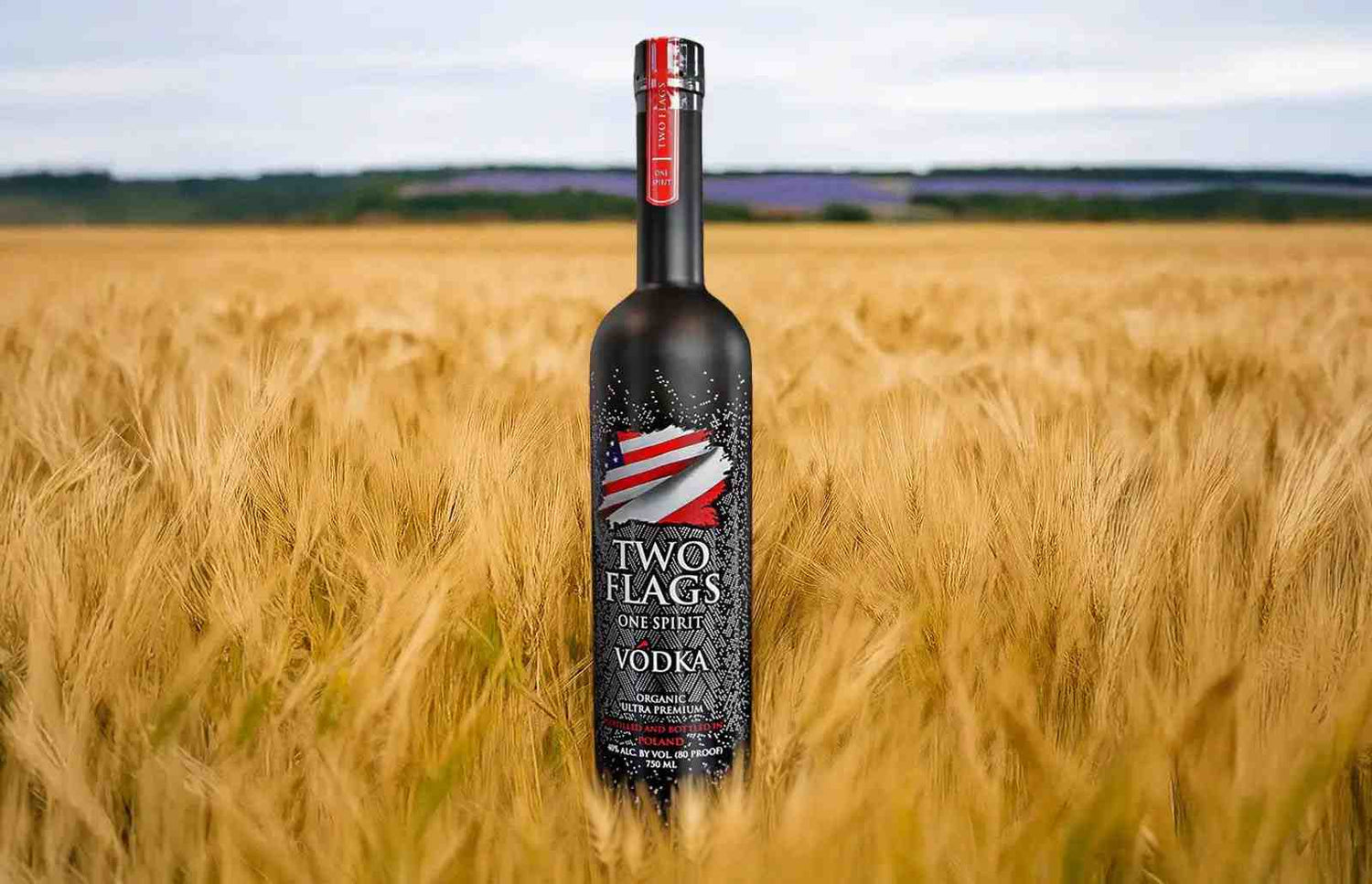
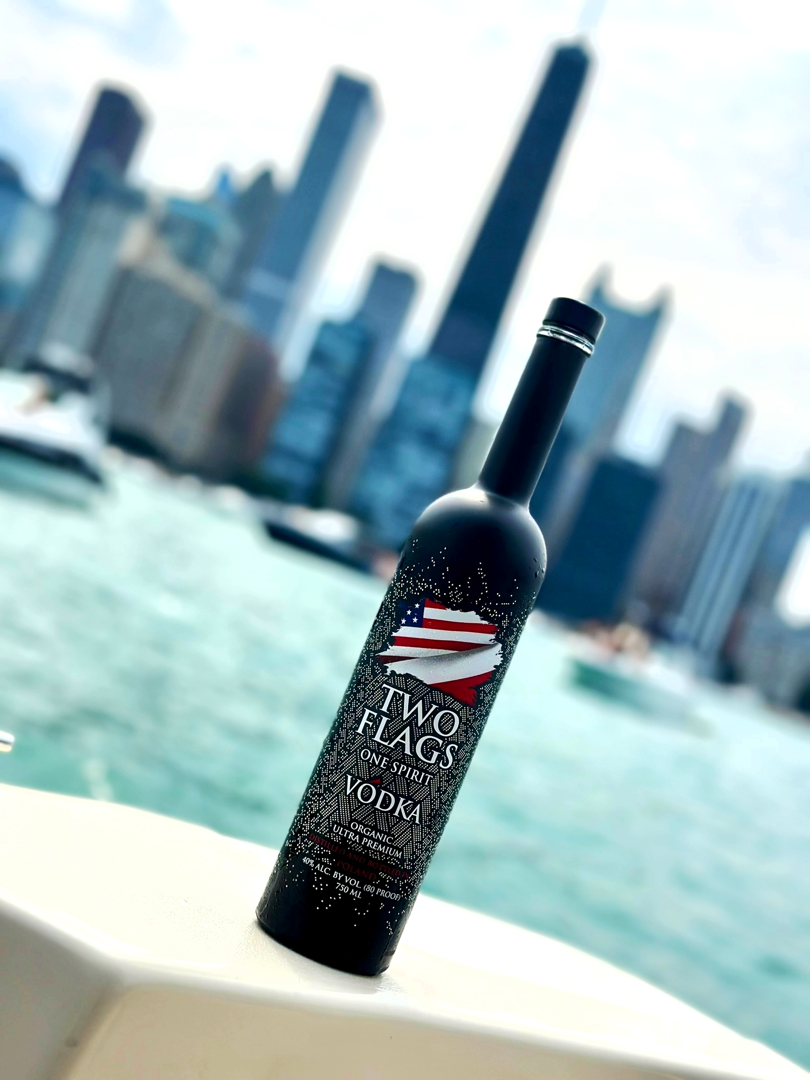
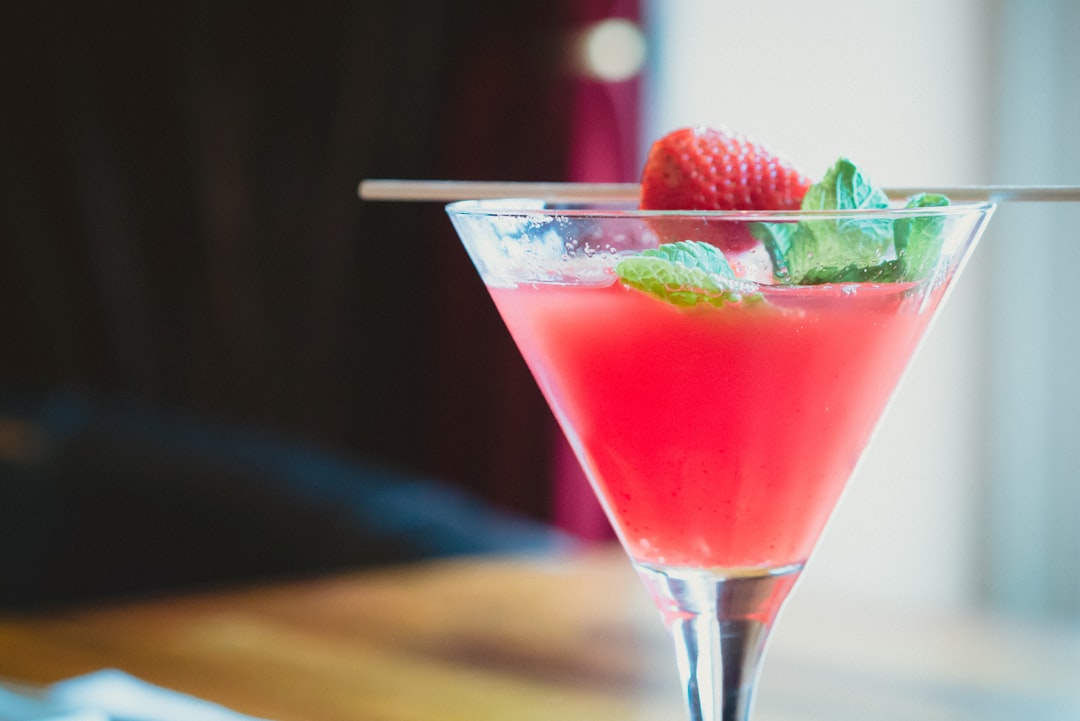
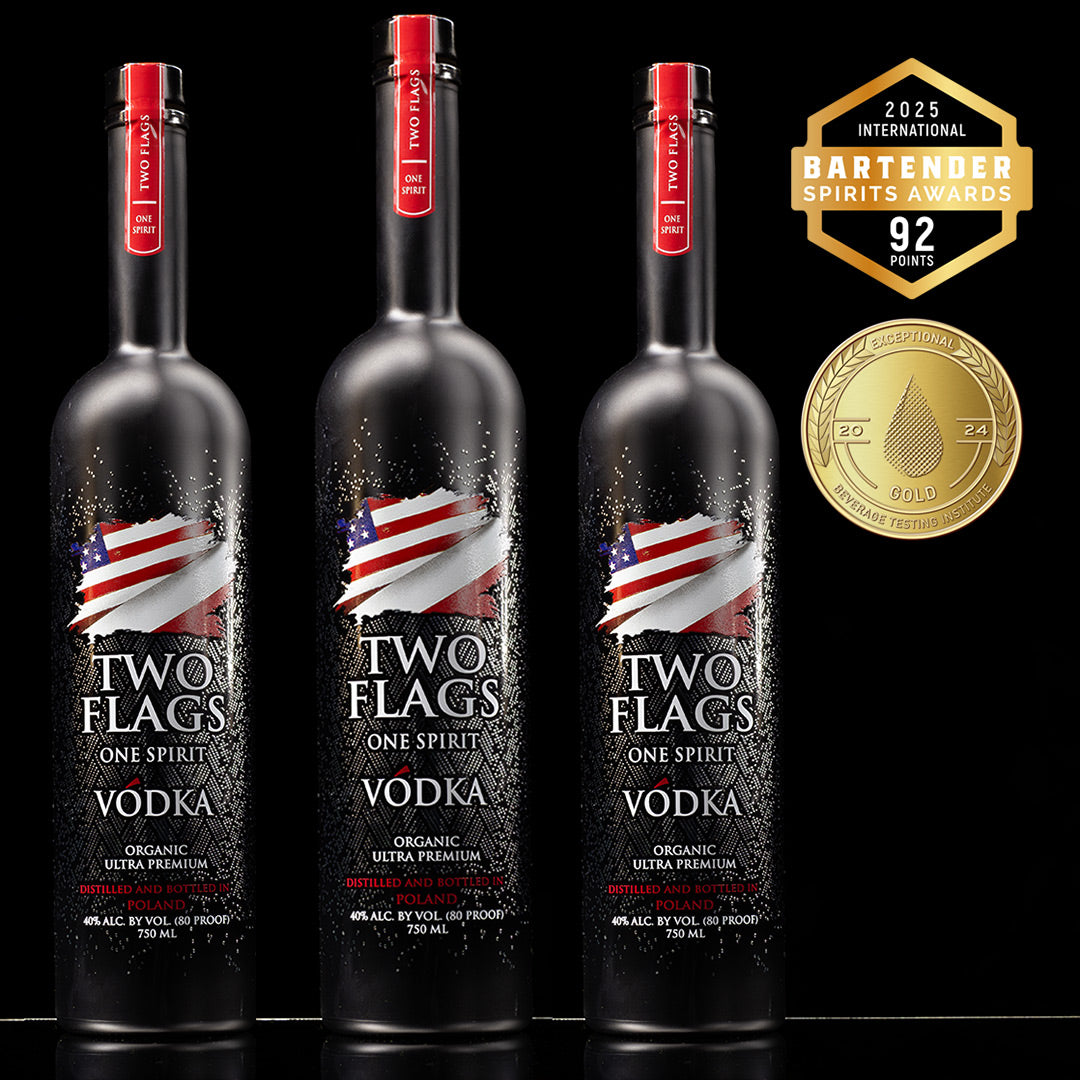
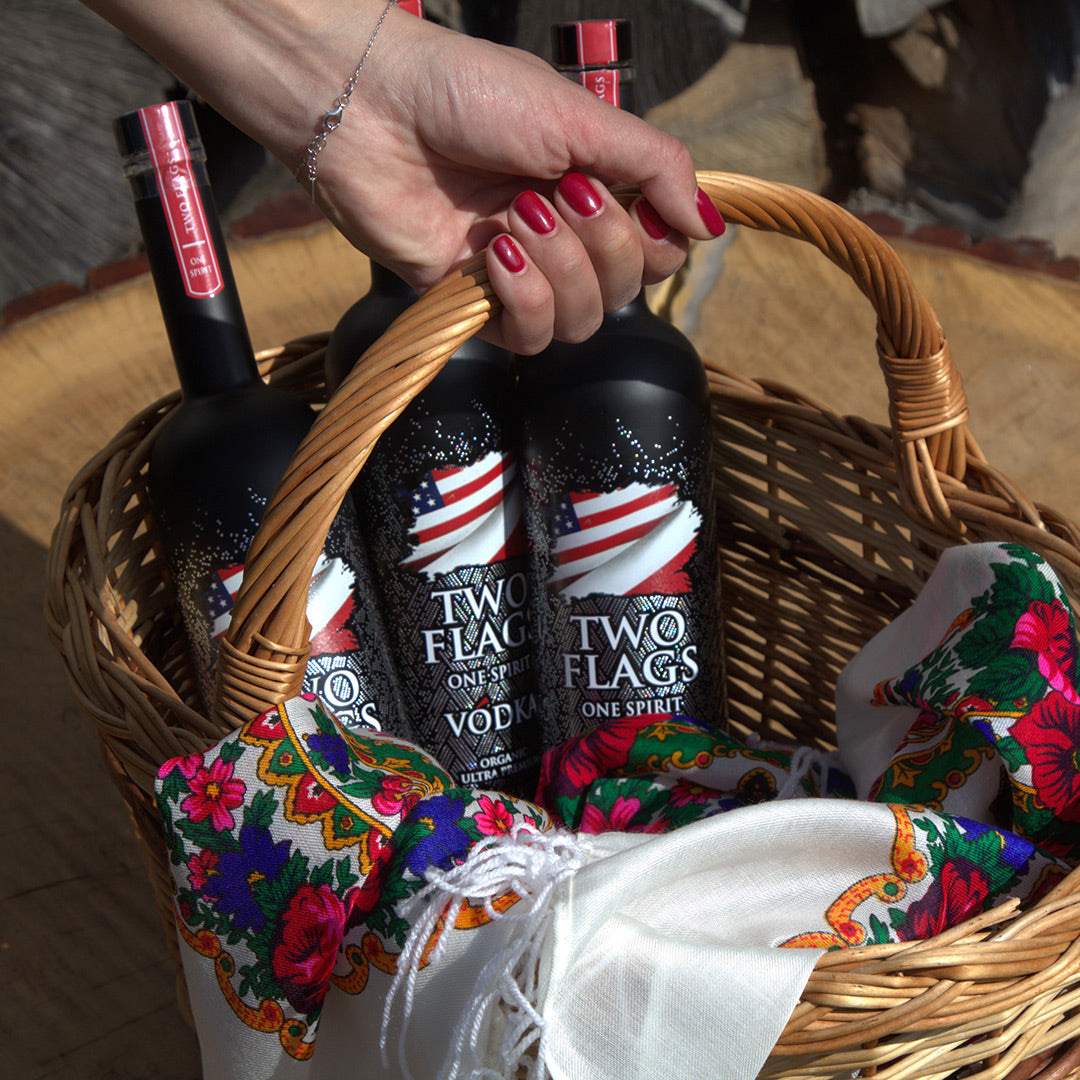

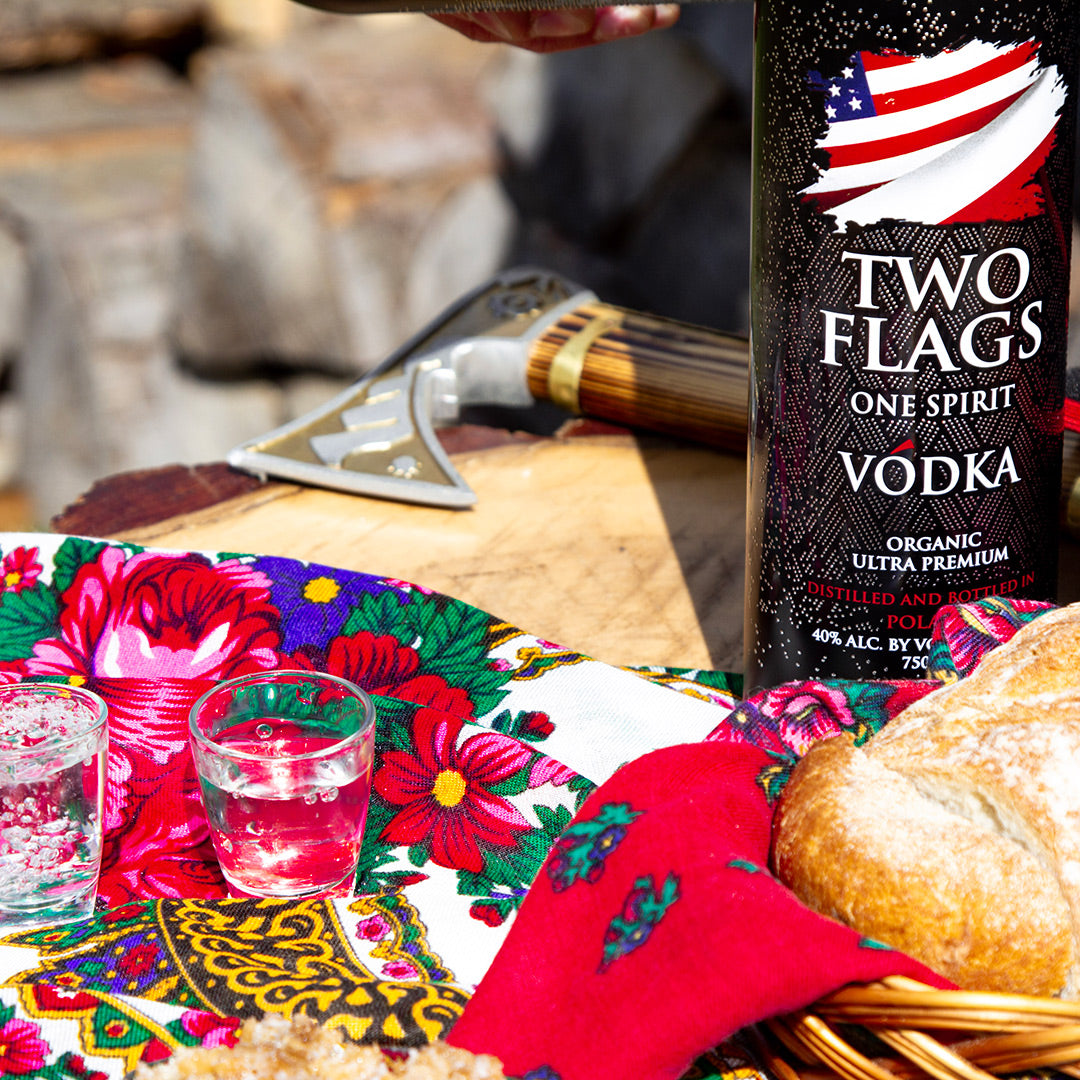

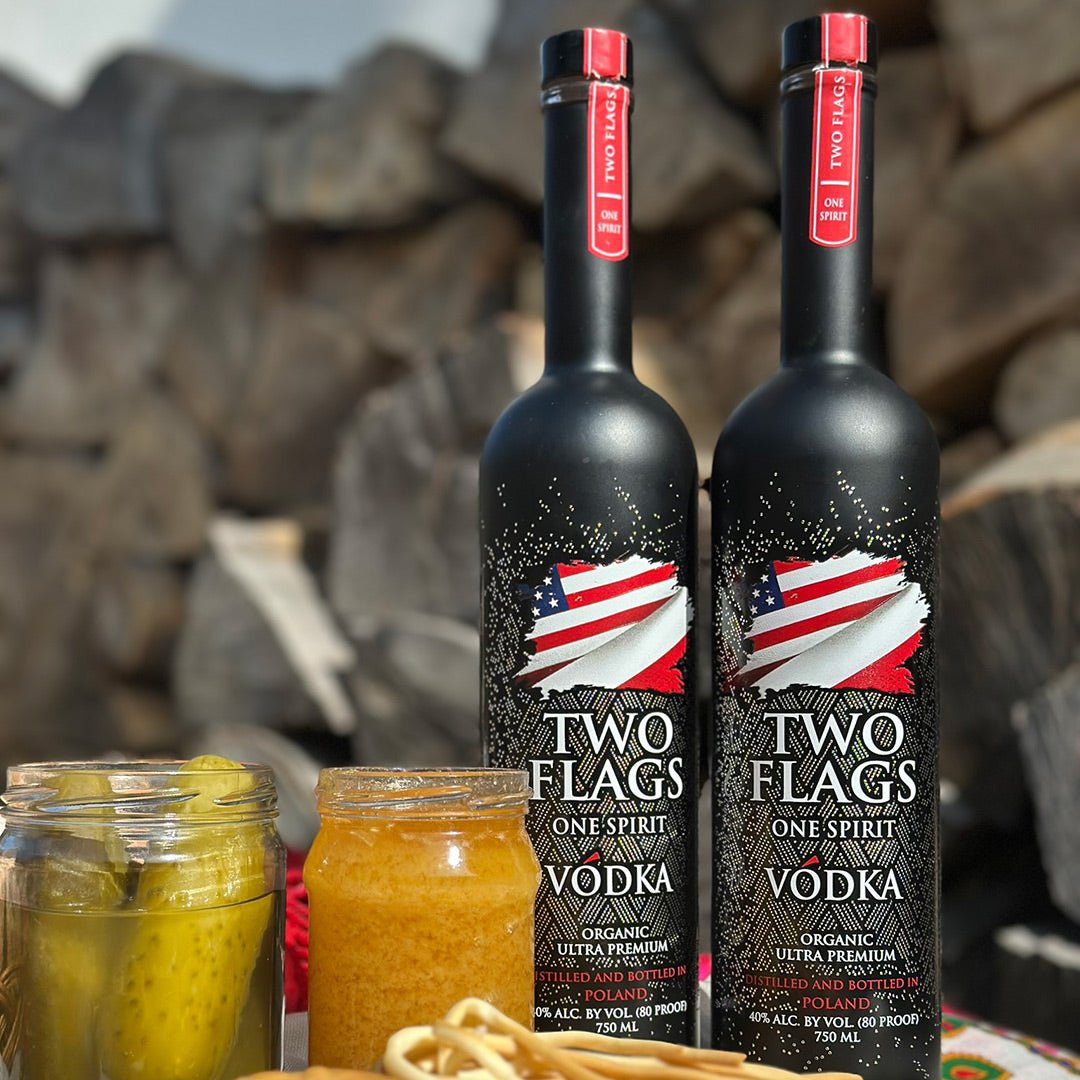
Zostaw komentarz
Ta strona jest chroniona przez hCaptcha i obowiązują na niej Polityka prywatności i Warunki korzystania z usługi serwisu hCaptcha.